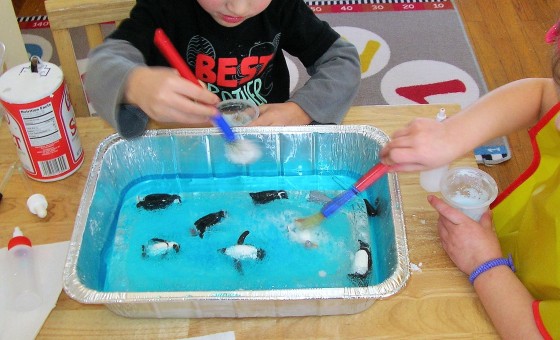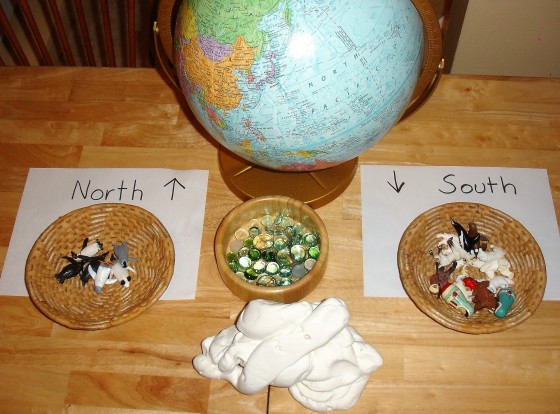
Penguins are such an engaging topic for young children that they can be presented as a sole theme or as part of a unit on polar animals.
When presenting science/nature topics to children, I try to focus on a few main facts that will stick with the children or ignite an interest to explore more in the future. I like to think that one day in elementary school, a subject will trigger a little memory of something they first learned with me in preschool.
Three Simple Facts to focus on:
–Emperor Penguins
Why? They are unique and interesting to children because of 1) their size and 2) the fact that the father penguins are in charge of caring for their eggs/chicks while the mothers swim off for weeks at a time in search of food.
–North Pole vs. South Pole
Why? A great way to introduce a globe and vocabulary words of locations like Arctic (North Pole) and Antartica (South Pole) and directional/positional words like Up/Down and Top/Bottom.
One of my favorite facts to share with little ones is that many of our favorite, well-known polar animals (polar bear, walrus, seals, beluga whales, Arctic fox, etc.) all live together at the North Pole (Arctic), but many our penguin friends live at the South Pole (Antartic).
A question to ask: Why can’t penguins play with polar bears? You’ll get many answers, such as polar bears would bite/eat the penguins (probably true), but it allows you to illustrate with your globe that polar bears live way at the very top of the world (North Pole), and penguins live way at the very bottom of the world (South Pole). It is definitely a fact that clicks with children and stays with them.
–Penguins are Birds (but can’t fly)
Why? Introduction to common bird traits — wings (but can’t fly), lay eggs, and they feed their babies through regurgitation (a wonderful vocabulary word that brings lots of “ewwwws”).
Three Favorite learning activities that leave an impression:
1. Math: Measure/Compare children’s size/height with life-size Emperor Penguin and/or average penguin.

2: Science: RESCUE THE PENGUINS! from an iceberg (individual icebergs or group cooperative activity) using salt, salt water and friction (paint brushes) to melt the ice. Wrapping Up the Activity: Some children will work a long time on this project (45 minutes or more), while others may drop out after 15 or 20 minutes, but often will circle back to the activity. If it is time to wrap up the activity due to time constraints, and the penguins are half-exposed from the ice: the teacher may ask children what else they should try OR “think out loud” that maybe warm water will melt the ice faster. Pouring a bit of hot water from the tap will usually release the individual penguins and satisfy those who worked so diligently.

Individual Icebergs (frozen in cups, inverted in bowls to catch liquid)

Group Activity – Free the Penguins

Group Activity – Free the Penguins

Group Activity – Penguins in a Block of Ice
Process:
-Freeze penguin figures in individual plastic cups or large container overnight using food coloring or Liquid Watercolors to tint water. Remove a few minutes before using to allow ice mold to release. Large Classrooms: this activity can be placed in your sensory table to allow different groups at a time work on this project over the course of the day.
-Provide salt, cups, droppers, mini squeeze bottles, and paint brushes as tools to help release the penguins. For larger group project, we used spoons toward the end to help chisel the penguins out. We did not use spoons for individual projects, as there would be less science involved and more whacking at the ice, possibly sending everything flying.
Supplies needed:
- Table Salt (large container)
- Water
- Droppers or Pipettes
- Small Squeese Bottles
- Paint Brushes
- Liquid Watercolor Paints or food coloring (Liquid watercolor paints are very vibrant and a little goes a long way. They are more versatile and economical than even cheap food coloring in the long run.)
3. Sensory / Loose Parts / Dramatic Play
Crayola Model Magic is a different kind of dough experience. When fresh out of the package, it is light and somewhat stiff. It can be pulled apart in chunks. Once warmed, it is pliable and can be stretched for fun. In this invitation to play, children use the Model Magic as snow, floating icebergs, and caves for penguins and/or polar animals. Gems are added for interest and often result in bodies of water for the animals. Little footprints are left in the dough as the animals move about.

Crayola Model Magic Dough, Gems, Polar Animals and Globe

Creating Caves and Floating Icebergs with Polar Animals (Although penguins and other animals live on separate poles, children are immersed in their own play.)
Supplies needed:
- Crayola Model Magic (white) – *Frugal Tip: can often be found at Michael’s or JoAnn Fabrics. You may find them on sale occasionally, but for best savings use a 50% off or other coupon off the full price.
- Toob of Penguins and/or Polar Animal figures *see Frugal Tip above
- Gems or other ice-like loose parts
Learning Goals:
- Science: Awareness/Experimentation of liquids/solids (water can be both); the affect of warmth/heat (temperature) on ice; making predictions
- Math: Size comparisons/measurement
- Geography: Pole locations and Continents
Theme extenders and tie-ins:
- Polar Animals
- Winter
- Continents
Updated Post: 2/8/19
Books Used with these Activities:





